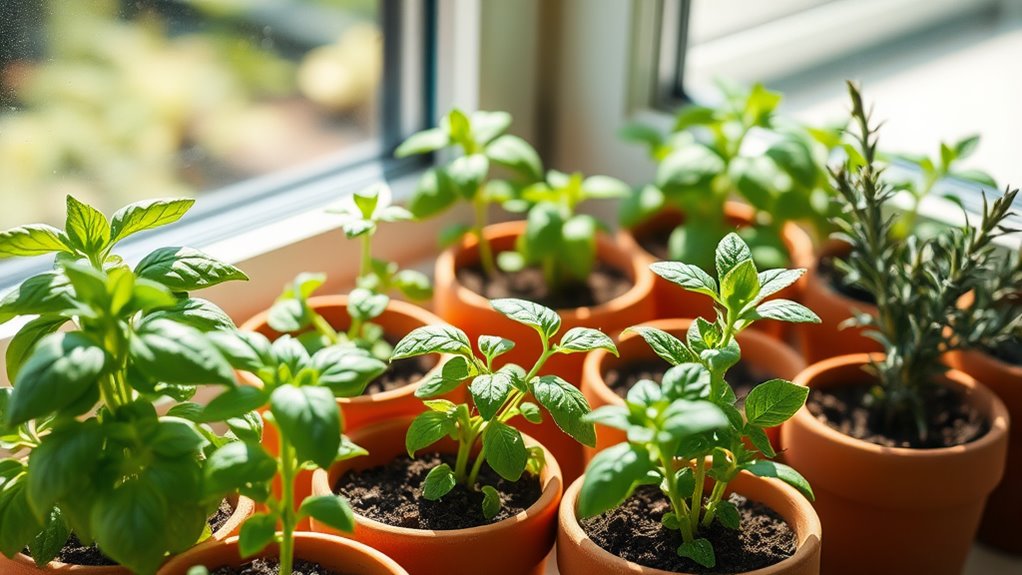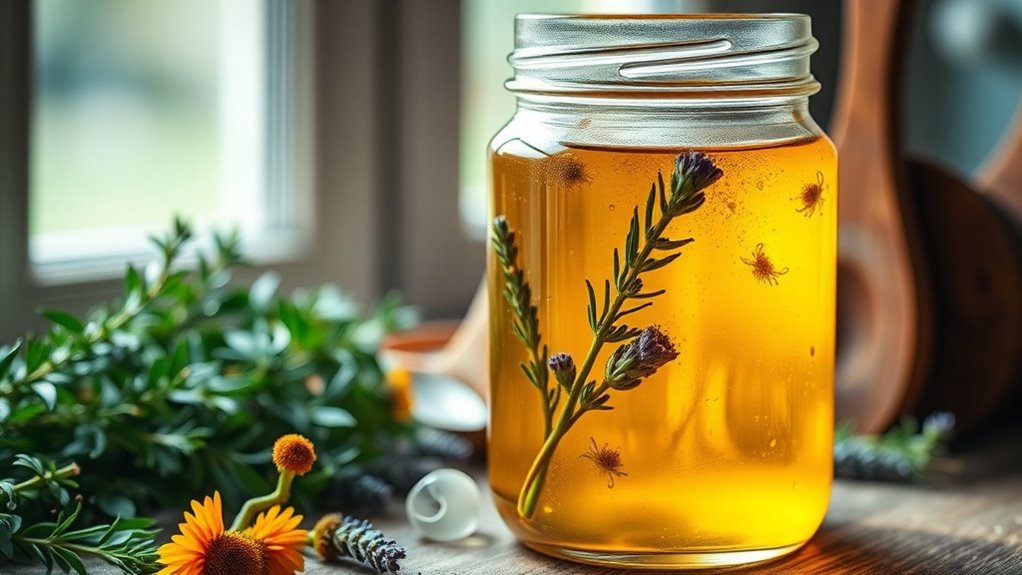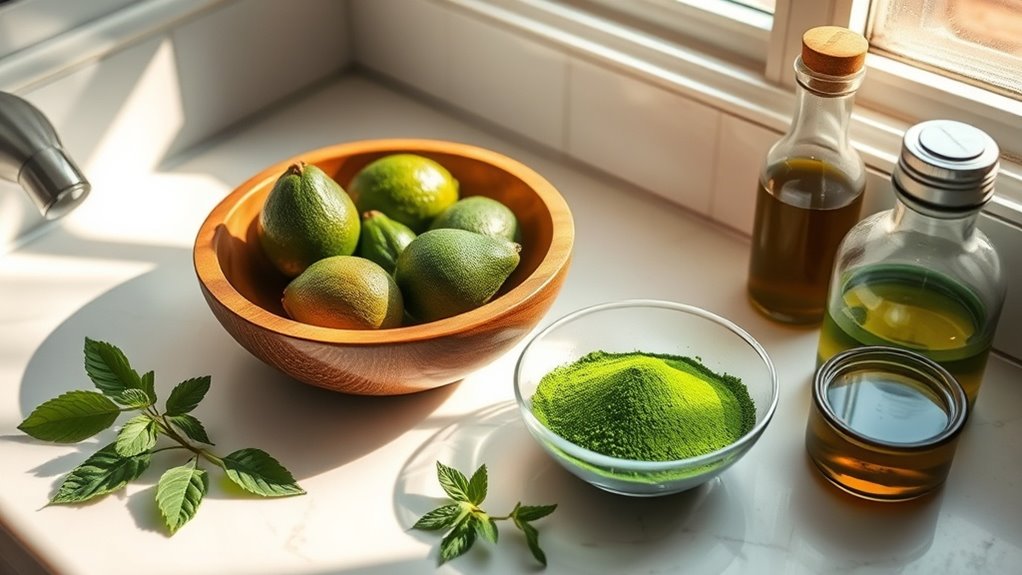Start Your Own Indoor Herb Garden (No Green Thumb Required)
You’ll easily start your own indoor herb garden, even without a green thumb, by picking beginner-friendly herbs like basil, mint, and chives for their tough growth habits. Grab essentials such as pots, quality potting soil, seeds or seedlings, and a watering can to keep things simple. Set up in a sunny spot with good drainage and air flow, then plant and water lightly to kick off growth. Maintain by checking soil moisture and pests regularly, and harvest leaves for fresh meals. Master these steps, and you’ll uncover even more ways to boost your green space.
Selecting Easy-to-Grow Herbs
When you’re setting up an indoor herb garden, choosing easy-to-grow herbs guarantees a thriving setup with minimal effort.
In easy herb gardening, prioritize basil for its rapid growth and pest resistance, mint for thriving in low light with minimal watering, and chives for their hardy, adaptable nature. Additionally, incorporating container gardening allows you to maximize your limited space while ensuring your herbs receive adequate drainage and nutrients. These selections guarantee you achieve lush results quickly, fostering a sustainable, rewarding indoor oasis that enhances your daily cooking.
Gathering Basic Supplies
To start your indoor herb garden, you’ll need a few essential supplies that form the foundation for success. Gather pots for planting, high-quality potting soil to support roots, fresh herb seeds or seedlings for starting growth, and a simple watering can for hydration. Select durable, affordable options to guarantee reliability. Additionally, consider using mason jars for planting as they provide unique aesthetics and adequate drainage when prepared correctly.
| Supply | Description |
|---|---|
| Pots | Containers to hold plants |
| Potting Soil | Nutrient-rich base |
| Seeds/Seedlings | Starting materials for herbs |
Preparing Your Growing Space
Now that you’ve gathered your supplies, it’s time to prepare your growing space by first selecting a location that offers good air circulation and protection from drafts.
You’ll then choose containers that are the right size for your herbs and have proper drainage to prevent root rot.
Finally, make sure lighting is adequate by positioning your setup near a sunny window or using grow lights to mimic natural sunlight. Additionally, consider using recycled jars for a sustainable approach to your herb garden setup.
Select Location
Where should you place your indoor herb garden to maximize growth and health?
Opt for a spot with ample indirect sunlight, like a south-facing window, providing at least six hours daily.
Avoid areas near heat sources or drafts to maintain stable temperatures between 65-75°F.
Maintain good air circulation without strong winds, and keep humidity moderate for ideal herb health.
Choose Containers
Choosing the right containers is essential for your indoor herb garden’s success.
They’ll provide the necessary drainage, space, and durability to keep your herbs healthy and thriving.
When selecting, focus on these essential factors:
- Drainage: Make sure containers have adequate holes to prevent water buildup and root rot.
- Size: Pick pots that allow room for root growth without being too large for your space.
- Material: Opt for breathable options like terracotta or lightweight plastic for ease and longevity.
Ensure Lighting
Ensuring your indoor herbs thrive means providing the right lighting in your growing space.
You should aim for 6-8 hours of direct sunlight each day by placing pots near a south or west-facing window.
If natural light is insufficient, especially in winter, set up grow lights that emit full-spectrum light for 12-16 hours daily.
Regularly check for signs of light deficiency, like yellowing leaves, and adjust accordingly to keep your herbs healthy and vigorous.
Planting and Initial Setup
Once you’ve assembled your materials, planting your indoor herb garden begins with selecting the right containers to guarantee proper drainage and root health.
Then, choose a well-draining potting mix and position herbs for growth.
For success, follow these steps:
- Fill containers with suitable mix, leaving space at the top.
- Plant seeds or seedlings at the recommended depth for each herb.
- Water initially to moisten soil without over-saturating.
Additionally, using proper drainage in your containers will help prevent root rot and promote healthy growth.
Daily Care and Maintenance Tips
You’ll manage your indoor herb garden’s watering schedule by checking soil moisture daily and watering only when the top inch feels dry, preventing root rot or dehydration.
Position your plants near a south-facing window for adequate light exposure, aiming for 6-8 hours of indirect sunlight to promote vigorous growth.
Regularly inspect leaves and stems for pests like aphids, removing them promptly to keep your herbs healthy and pest-free. Additionally, consider rotating your pots every few weeks to ensure all sides receive equal light exposure and prevent uneven growth.
Watering Schedule
Maintaining a consistent watering schedule is essential for the health of your indoor herb garden.
This prevents root rot and helps herbs stay hydrated without excess moisture.
You’ll avoid common issues by following these key steps:
-
Check the top inch of soil daily; water only if it’s dry to the touch.
-
Use room-temperature water, applying it directly to the base until it drains.
-
Allow soil to partially dry between waterings, typically every 3-7 days depending on the herb.
Light Exposure
While managing your watering schedule keeps roots healthy, you now need to address light exposure to optimize herb growth.
Most herbs require six to eight hours of bright, indirect light daily to thrive.
Position your plants near a south-facing window for natural sunlight, or use energy-efficient LED grow lights if needed.
Monitor for leggy stems as a sign of insufficient light, and rotate pots regularly to promote even growth and prevent weak spots.
Pest Checks
Regularly inspect your indoor herbs for pests to safeguard their health and vigor.
Pests like aphids can harm your plants quickly, so check daily for early detection.
Follow these essential steps:
- Examine leaves and stems for signs such as webbing, spots, or tiny insects.
- Remove pests manually with a damp cloth or apply insecticidal soap immediately.
- Isolate affected herbs and monitor closely to prevent infestations from spreading.
Harvesting and Using Your Herbs
Once you’ve nurtured your indoor herbs to maturity, it’s time to harvest them carefully to maximize flavor and encourage regrowth.
Use sharp scissors to snip leaves just above a growth node, ideally in the morning.
For use, add fresh herbs to meals for vibrant taste, or dry them in a warm spot and store in airtight jars to preserve potency and extend shelf life.





